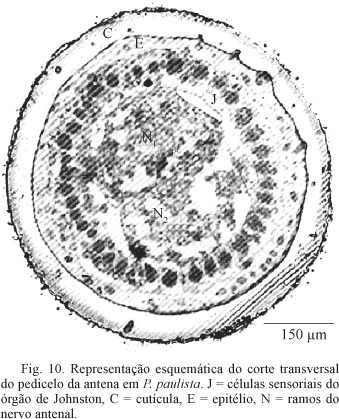Among the communication strategies used by the animals, the sound is one of the most important. Hymenoptera have as auditory organs, the subgenual organ (SGO) located in the tibia proximal portion, and the Johnston organ (JO) located in the second antenna segment. The subject of this work was to analyze the morphology of these structures in Agelaia pallipes (Olivier), Polybia paulista (Ihering) and Mischocyttarus cassununga (Ihering). The tibiae and antennae of the three species were dissected and fixed in 2% glutaraldhyde in 0, 2 M sodium cacodylate buffer, pH 7.4, during 2h, at 4ºC. Afterward, they were postfixed in 2% osmium tetroxide in the same buffer. We observed similarity in the shape, location and size of both, SGO and JO, among the studied species. SGO presented a conical shape formed by nervous cells fixed to the internal wall of the tibia on lateral and opposite points. Such structure and its location seem to constitute strategies to perceive vibratory stimulations originated from the substratum. In the pedicellum of the three species antenna, we observed JO sensorial cells, disposed in a radial form, ending in the cuticular connection between the pedicellum and the antennal flagella. This arrangement allows the JO to detect vibratory stimuli. In this work, a possible relation between morphology of the sensorial structures and the development of hearing in the different species was not analyzed.
subgenual organ; Johnston's organ; vibrational signal; mechanoreception










